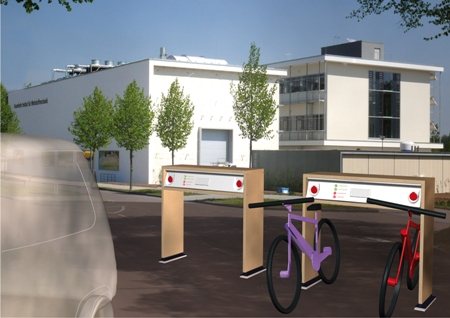The growing number of road side electric vehicle charging facilities in Germany, which presently sport steel or aluminum -clad pillars and housing will soon be constructed using eco-friendly materials. The researchers for Mechanics of Materials IWM at Halle facility of Fraunhofer Institute are in the process of improving the current image of EV charging facilities in association with Bosecker Verteilerbau Sachsen, their industrial partner.
 Tomorrow’s EV charging stations will be clad in eco-friendly reconstituted wood products. Credit: Fraunhofer IWM
Tomorrow’s EV charging stations will be clad in eco-friendly reconstituted wood products. Credit: Fraunhofer IWM
They are planning to substitute the present steel cladding structure that secures the electronic switchgear, power outlets and cables with honeycomb boards manufactured utilizing a wood plastic composite (WPC). WPC is a mix of natural fiber containing 30% thermoplastic polypropylene and 70% cellulosic wood fiber produced utilizing sustainable resources. The product in addition to having increased level of sustainable substances, does not use tropical timber and is 100% recyclable. The composites can be recycled for a number of times into new products and does not leave a carbon footprint.
According to Sven Wüstenhagen, an IWM researcher in Halle, the trees absorb large quantities of carbon dioxide from the environment when they grow and retain the same in their ligneous fibers, thus ensuring that using of WPC in the construction of charging facilities instead of steel will reduce the level of carbon dioxide discharge. WPC is manufactured under an extrusion procedure which requires melting of thermoplastic resin and wood fibers mix at higher level pressure and temperature and feeding the viscous output into the mold continuously. The technology allows adding of fibers to the resin mixture in their natural form without the need of changing them into granulates, thus doing away with the need of an energy consuming intermediary process and up-keeping of the fibers’ quality. The high thermal sensitivity of wood requires less than 200°C temperature for processing.
The housings for the charging facilities are produced in the form of modular components in a range of designs and shapes to facilitate easy assembling at the site and to merge with the existing construction architecture. The panels can be easily removed for repairs and all the cable management systems and cable holders required for the EV charging facilities can be integrated within the modular construction by utilizing the easy shape forming attribute of WPC. The researchers are presently testing the sample materials for their vulnerability against prolonged UV exposure, higher levels of humidity, variations in temperature, endurance to impact and shatterproof attributes to determine the type of additives and coatings. The prototype WPC construction is being tested under normal conditions.